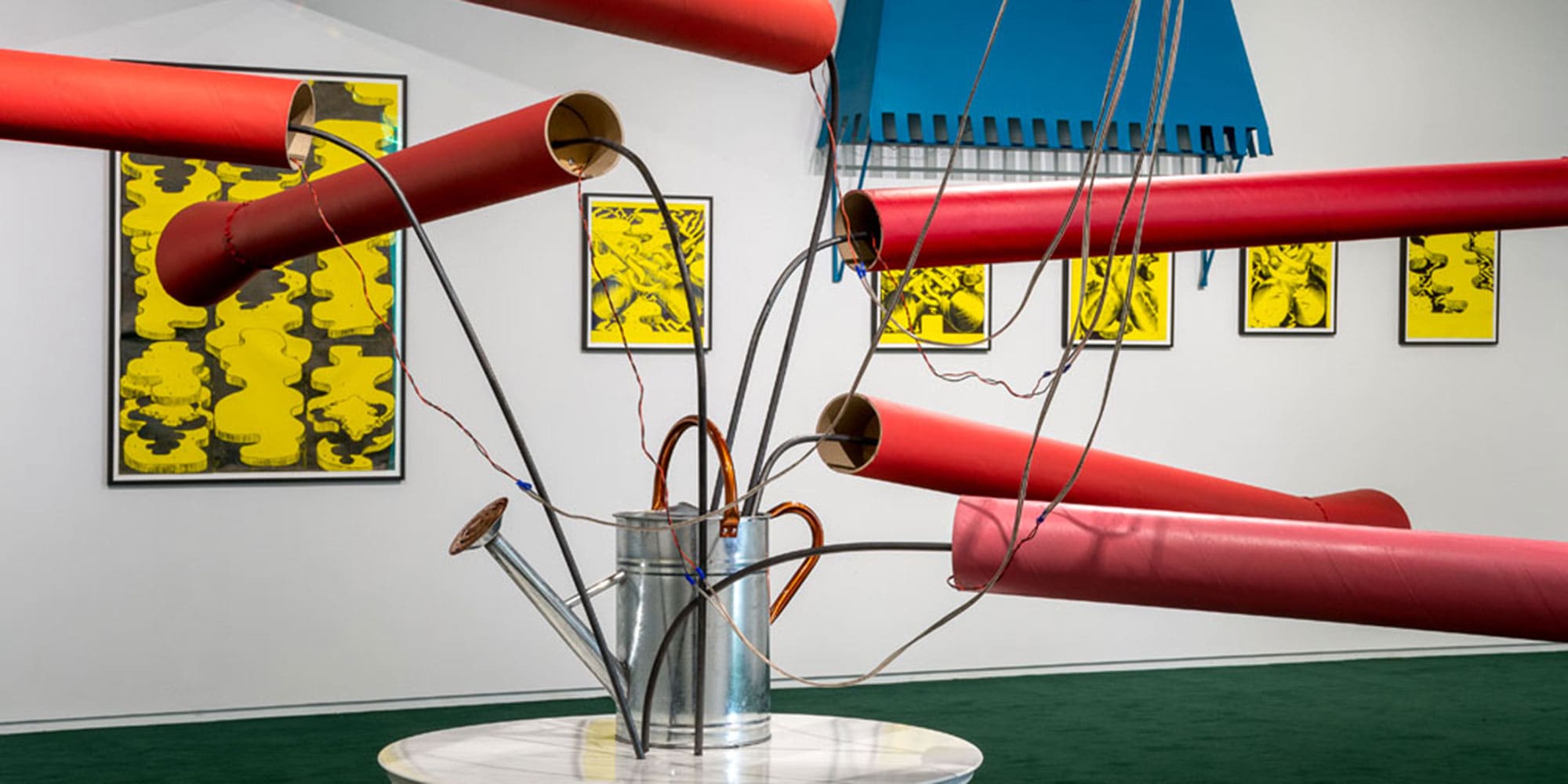
Installation view of Early Awnings: Henning Bohl with Sergei Tcherepnin at Blaffer Art Museum. Nash Baker Photography
Early Awnings: Henning Bohl with Sergei Tcherepnin
May 30—September 5, 2015
Early Awnings is a collaboration between German artist Henning Bohl and American artist Sergei Tcherepnin. Organized by Blaffer director and chief curator Claudia Schmuckli, the exhibition combines sculptures, drawings, and sound into an immersive installation that imbues objects and imagery with fantastic forms and symbols to serve as a multidimensional platform for storytelling.Grounded in feelings of malaise with the state of the world and invested in the creative exploration of vulnerability and fear, Bohl has created a series of fantasy illustrations entitled Kadath Fatal that draw inspiration from the imagery evoked in the literary genres of Cosmic Horror and Fantasy of Manners and the visual language of related graphic novels. The series borrows its title from American author H. P. Lovecraft’s novella The Dream Quest of Unknown Kadath (1926/27)—Kadath being a mythical peak where gods dwell “in the cold waste where no man treads.” However, unlike Lovecraft (1890-1937), whose illustrated novels locate fear in an inconceivable “other” descending to earth from outer space, Bohl brings those horrors closer to home. Turning cheese, cakes, ribbons and cornets—traditionally given to every German child on her first day of school—into monstrous presences, he conjures the subtle forms of terror and estrangment that await us in the everyday.
As striking for their overwhelmingly yellow palette as for their fantastical imagery, Bohl’s drawings invoke the signature style of British author and illustrator Aubrey Beardsely (1872-1898), who, along with American writer Henry Harland (1861-1905) co-edited The Yellow Book (1894-97), a leading British arts and literary periodical associated with Aestheticism and Decadence that helped define the last decade of the 19th century as “The Yellow Nineties.”
Complementing the drawings is a series of fabricated metal awnings installed along the perimeter of the gallery. They serve as both framing devices for the drawings as well as projection devices for the sound installation developed with Tcherepnin. Bohl considers awnings to be strange objects when contemplated on their own. Often beautiful but aesthetically alien to the facades they are attached to, they have no true architectural function other than marking and easing the transition from one domain into another. Transposed into a gallery setting, the awnings become symbolic markers of transition and literally set the stage for a play that brings the real (the physical installation in the gallery) and the imaginary (the realm evoked through drawings, text, and audio) into conversation.
A large sculpture of a withered bouquet of elongated, hornlike forms—resembling the empty, levitating cornucopia seen in many of the drawings—occupies the center of the room, complete with table and a bottomless watering pot. Set against the background of a moss green carpet, its “blooms” offer floral interpretations of the alphorn, a distinctive wooden horn instrument found in Europe’s alpine regions, while its built-in speakers project sound into the gallery.
Just as the drawings’ conical shapes formally recall the flower horns, the awnings literally echo the sounds coming from the sculpture, creating a musical dialogue in which the bouquet and the awnings are both actors and musicians. Written and recorded by Bohl and Tcherepnin, the sounds conflate gothic, baroque and folk elements edited into the repetitive pattern typical of soundtracks for video games. In a sonic play of call and response, the awnings intermittently come alive with a different sound, forming and asserting their own “voices” from different points in space before disappearing again into the background.
Henning Bohl lives and works in Hamburg, Germany. His work has been exhibited regularly at Casey Kaplan Gallery, New York; Johan König Gallery, Berlin; Galerie Karin Günther, Hamburg; and Meyer Kainer Gallery, Vienna. Recent solo and group exhibitions inclulde Hamburger Bahnhof, Castillo Corrales, Paris; Berlinische Galerie, Kunsthalle Nürnberg; Kunstverein Hamburg, Bergen Kunsthall, ICA, London, the Carnegie Museum of Art, Pittsburgh; the Australian Centre for Contemporary Art, Melbourne; Kunsthalle Baden Baden, Pro Choice, Vienna, Bundeskunsthalle Bonn; the Seattle Art Museum; ArtPace, San Antonio; Portikus Frankfurt am Main, Tokyo Wonder Site, Cubitt, London, Witte de With, Rotterdam; and White Columns, New York.
Sergei Tcherepnin lives and works in New York. His work has recently been exhibited at Halle Für Kunst, Lüneburg; MIT List Visual Arts Center, Cambridge, MA; the Portland Institute of Contemporary Art; and Karma, Zurich; Audio Visual Arts, New York; Taka Ishii Gallery, Tokyo; CAC Brétigny and the Showroom, London. and has been included exhibition at the Carnegie Museum of Art, Pittsburgh; the 55th Venice Biennale, the Museum of Modern Art, New York; and the Portland Institute of Contemporary Art. His major site-specific sound and sculptural installation was part of the 30th Bienal de São Paulo. Recent performances include The Solomon R. Guggenheim Museum, New York; The Art Institute of Chicago with Das Institut and United Brothers; Issue Project Room, Brooklyn, with Woody Sullender; the 30th Bienal de São Paulo with Jutta Koether and Yuki Kimura; Gavin Brown’s Enterprise, New York; with Das Institut and United Brothers. As an integral member of the late Maryanne Amacher’s research team, Tcherepnin collaborated on an exhibition of her archive at the DAAD Galerie, Berlin and a series of related performances.
